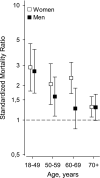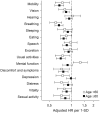Worse health-related quality of life, impaired functioning and psychiatric comorbidities are associated with excess mortality in patients with severe chronic pain
- PMID: 35278251
- PMCID: PMC9310830
- DOI: 10.1002/ejp.1938
Worse health-related quality of life, impaired functioning and psychiatric comorbidities are associated with excess mortality in patients with severe chronic pain
Abstract
Background: Severe chronic pain that interferes with daily activities is associated with an increased risk of mortality. We assessed the overall mortality of tertiary chronic pain patients in comparison with the general population, with a special aim to analyse the association of health-related quality of life (HRQoL) and its dimensions with the risk of death.
Methods: In this prospective observational follow-up study, patients with non-cancer chronic pain attended an outpatient multidisciplinary pain management (MPM) episode in a tertiary pain clinic in 2004-2012 and were followed until May 2019. Mortality between the patients and the general population was compared with standardized mortality ratios (SMR) in different age groups. Causes of death and comorbidities were compared among the deceased. Association of mortality and HRQoL and its dimensions, measured with the 15D instrument, was studied with Cox proportional hazards model.
Results: During a mean of 10.4-year follow-up of 1498 patients, 296 died. The SMR in the youngest age group (18-49 years) was significantly higher than that of the general population: 2.6 for males and 2.9 for females. Even elderly females (60-69 years) had elevated mortality (SMR 2.3). Low baseline HRQoL at the time of MPM, as well as poor ratings in the psychosocial dimensions of HRQoL, was associated with an increased risk of death.
Conclusions: Our results support the role of HRQoL measurement by a validated instrument such as the 15D in capturing both the physical and the psychological symptom burden, and consequently, an elevated risk of death, in patients with chronic pain.
Significance: Severe chronic pain is associated with elevated mortality. In patients in chronic pain under 50 years old, the mortality was 2.5-3 times higher than in the general population. Psychological distress appears to contribute to the increased mortality. Regular follow-up by health-related quality of life (HRQoL) measurement could be useful in identifying patients in chronic pain who are in need of intensive symptom management and to prevent early death.
© 2022 The Authors. European Journal of Pain published by John Wiley & Sons Ltd on behalf of European Pain Federation - EFIC ®.
Conflict of interest statement
All authors have completed the ICMJE uniform disclosure form. Pekka Vartiainen reports personal fees (lecture fee) from Orion Pharma, outside the submitted work. Eija Kalso reports personal fees (advisory board membership) from Pfizer and Orion Pharma, outside the submitted work. The authors report no other relationships or activities that could appear to have influenced the submitted work. The study sponsors had no part in the study design, and the study was carried out independently from the sponsors.
Figures



References
Publication types
MeSH terms
LinkOut - more resources
Full Text Sources
Medical

